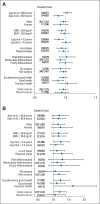Pre- and postdiagnosis physical activity, television viewing, and mortality among patients with colorectal cancer in the National Institutes of Health-AARP Diet and Health Study
- PMID: 25488967
- PMCID: PMC4279238
- DOI: 10.1200/JCO.2014.58.1355
Pre- and postdiagnosis physical activity, television viewing, and mortality among patients with colorectal cancer in the National Institutes of Health-AARP Diet and Health Study
Abstract
Purpose: Physical inactivity has been associated with higher mortality risk among survivors of colorectal cancer (CRC), but the independent effects of pre- versus postdiagnosis activity are unclear, and the association between watching television (TV) and mortality in survivors of CRC is previously undefined.
Methods: We analyzed the associations between prediagnosis (n = 3,797) and postdiagnosis (n = 1,759) leisure time physical activity (LTPA) and TV watching and overall and disease-specific mortality among patients with CRC. We used Cox proportional hazards regression to estimate hazard ratios (HRs) and 95% CIs, adjusting for known mortality risk factors.
Results: Comparing survivors of CRC reporting more than 7 hours per week (h/wk) of prediagnosis LTPA with those reporting no LTPA, we found a 20% lower risk of all-cause mortality (HR, 0.80; 95% CI, 0.68 to 0.95; P for trend = .021). Postdiagnosis LTPA of ≥ 7 h/wk, compared with none, was associated with a 31% lower all-cause mortality risk (HR, 0.69; 95% CI, 0.49 to 0.98; P for trend = .006), independent of prediagnosis activity. Compared with 0 to 2 TV hours per day (h/d) before diagnosis, those reporting ≥ 5 h/d of TV before diagnosis had a 22% increased all-cause mortality risk (HR, 1.22; 95% CI, 1.06 to 1.41; P trend = .002), and more postdiagnosis TV watching was associated with a nonsignificant 25% increase in all-cause mortality risk (HR, 1.25; 95% CI, 0.93 to 1.67; P for trend = .126).
Conclusion: LTPA was inversely associated with all-cause mortality, whereas more TV watching was associated with increased mortality risk. For both LTPA and TV watching, postdiagnosis measures independently explained the association with mortality. Clinicians should promote both minimizing TV time and increasing physical activity for longevity among survivors of CRC, regardless of previous behaviors.
© 2014 by American Society of Clinical Oncology.
Conflict of interest statement
Authors' disclosures of potential conflicts of interest are found in the article online at
Figures



Similar articles
-
Postdiagnostic physical activity, sleep duration, and TV watching and all-cause mortality among long-term colorectal cancer survivors: a prospective cohort study.BMC Cancer. 2017 Oct 25;17(1):701. doi: 10.1186/s12885-017-3697-3. BMC Cancer. 2017. PMID: 29070017 Free PMC article.
-
Television watching and colorectal cancer survival in men.Cancer Causes Control. 2015 Oct;26(10):1467-76. doi: 10.1007/s10552-015-0645-x. Epub 2015 Aug 21. Cancer Causes Control. 2015. PMID: 26293240 Free PMC article.
-
Associations of recreational physical activity and leisure time spent sitting with colorectal cancer survival.J Clin Oncol. 2013 Mar 1;31(7):876-85. doi: 10.1200/JCO.2012.45.9735. Epub 2013 Jan 22. J Clin Oncol. 2013. PMID: 23341510
-
Sedentary lifestyle and risk of obesity and type 2 diabetes.Lipids. 2003 Feb;38(2):103-8. doi: 10.1007/s11745-003-1038-4. Lipids. 2003. PMID: 12733740 Review.
-
Aspirin use after diagnosis but not prediagnosis improves established colorectal cancer survival: a meta-analysis.Gut. 2015 Sep;64(9):1419-25. doi: 10.1136/gutjnl-2014-308260. Epub 2014 Sep 19. Gut. 2015. PMID: 25239119 Review.
Cited by
-
Which cancer survivors are at risk for a physically inactive and sedentary lifestyle? Results from pooled accelerometer data of 1447 cancer survivors.Int J Behav Nutr Phys Act. 2019 Aug 16;16(1):66. doi: 10.1186/s12966-019-0820-7. Int J Behav Nutr Phys Act. 2019. PMID: 31420000 Free PMC article.
-
The Role of Aspirin, Vitamin D, Exercise, Diet, Statins, and Metformin in the Prevention and Treatment of Colorectal Cancer.Curr Treat Options Oncol. 2015 Sep;16(9):43. doi: 10.1007/s11864-015-0359-z. Curr Treat Options Oncol. 2015. PMID: 26187794 Review.
-
Physical inactivity and head and neck cancer mortality.Head Neck. 2020 Sep;42(9):2516-2523. doi: 10.1002/hed.26283. Epub 2020 Jun 1. Head Neck. 2020. PMID: 32478442 Free PMC article.
-
Exercise and cancer: a position statement from the Spanish Society of Medical Oncology.Clin Transl Oncol. 2020 Oct;22(10):1710-1729. doi: 10.1007/s12094-020-02312-y. Epub 2020 Feb 13. Clin Transl Oncol. 2020. PMID: 32052383 Free PMC article.
-
Racial and Ethnic Differences in Dietary Intake, Physical Activity, and Body Mass Index (BMI) Among Cancer Survivors: 2005 and 2010 National Health Interview Surveys (NHIS).J Racial Ethn Health Disparities. 2017 Dec;4(6):1138-1146. doi: 10.1007/s40615-016-0319-8. Epub 2017 Jan 11. J Racial Ethn Health Disparities. 2017. PMID: 28078657
References
-
- American Cancer Society. Cancer Facts and Figures 2014. Atlanta, GA: American Cancer Society; 2014.
-
- Haskell WL, Lee IM, Pate RR, et al. Physical activity and public health: Updated recommendation for adults from the American College of Sports Medicine and the American Heart Association. Circulation. 2007;116:1081–1093. - PubMed
-
- Friedenreich CM, Neilson HK, Lynch BM. State of the epidemiological evidence on physical activity and cancer prevention. Eur J Cancer. 2010;46:2593–2604. - PubMed
-
- Blanchard CM, Courneya KS, Stein K. Cancer survivors' adherence to lifestyle behavior recommendations and associations with health-related quality of life: Results from the American Cancer Society's SCS-II. J Clin Oncol. 2008;26:2198–2204. - PubMed
Publication types
MeSH terms
Grants and funding
LinkOut - more resources
Full Text Sources
Medical

